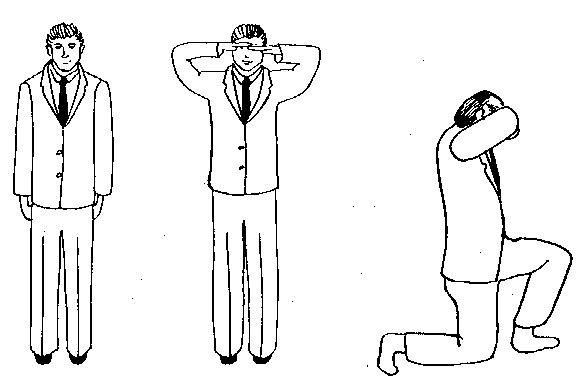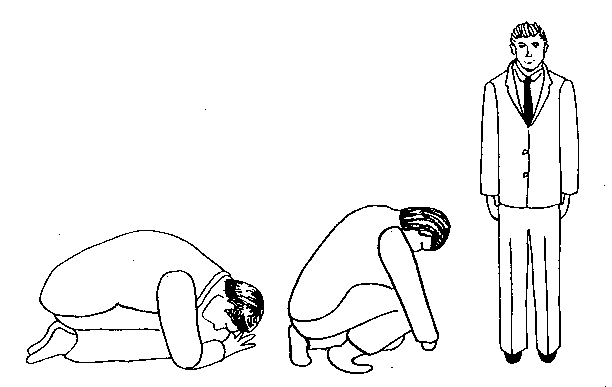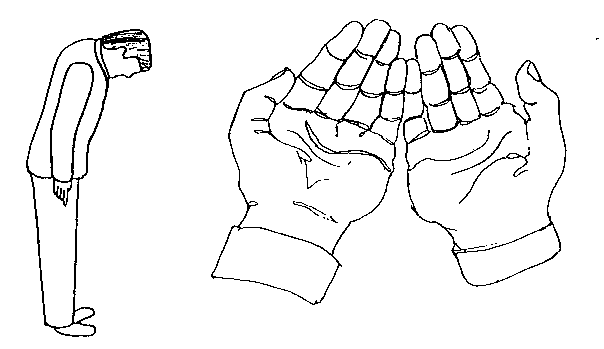 1.1. Hands at side, feet slightly apart
1.1. Hands at side, feet slightly apart
Unification Church members live their lives attending God, True Parents, and central figures. Yet each of us must remember that the important aspect of keeping a tradition is our attitude, not the ritual itself.
In attending God and True Parents our attitude should be to comfort God's heart; we should not feel that traditions are compulsory based on our duty to some church law. If we realize that we have lost the proper attitude, we can repent and develop a strategy for overcoming our fallen nature.
Whether a tradition is an internal point of attitude or an external ceremony, it can draw us to our real Parent, God, through the respect and love we show. Traditions can further close the gap that exists between the True Parents and ourselves.
The True Parents established the ceremonies and traditions of our movement with deep love for God; they had to go through many difficulties and tribulations in order to do so. In learning from the traditions they teach us, we should attend God and True Parents as children, with a heart of fidelity and filial piety.
Whenever we serve our central figures, we symbolically minister to God and True Parents. We cannot attend someone based on only an intellectual understanding of attendance, but must first cultivate a heartfelt attitude of love for God, True Parents, and our central figure through respect and actual service.
Unless we realize certain points of etiquette, it is difficult to fully attend the True Parents themselves or a central figure.
Several points of attendance etiquette are included in chapter 22, Blessed Family Practices. Basic points will be presented here. However, this by no means is inclusive of all attendance; other points will be covered in The Tradition, Book Two.
The tradition of bowing is much more developed in the East than the West. Therefore, whether to bow or what type of bow to offer either an Oriental or Western central figure may be a point of confusion. An attitude of respect is much more meaningful than whether or not one bows.
Full bows are used during Pledge services, Seung Hwa, Eight Day Dedication and Three Day ceremonies, etc.
 1.1. Hands at side, feet slightly apart
1.1. Hands at side, feet slightly apart
 1.2. Bring hands to eyebrow level; right hand/fingers
slightly overlapping
1.2. Bring hands to eyebrow level; right hand/fingers
slightly overlapping
 1.3. Bend and go down on right knee first (or both at same
time)
1.3. Bend and go down on right knee first (or both at same
time)
Never rush through a full bow; it should be done slowly, deliberately and respectfully.
When bowing with many other people, follow the person leading. As much as possible, bows should be done in unison.
It is not considered respectful to look directly at the True Parents (either in person or in a picture) when bowing; keep eyes at approximately forty-five degrees downward.
Stand with feet slightly apart, hands to the side (diagram 1.1). Raise both arms slowly, with dignity (diagram 1.2), bringing the hands to eyebrow level. Hands should be straight, right fingers on top of left fingers. Our two hands represent sung sang and hyung sang or Abel and Cain, and must be placed in harmony.
Kneel down, either on both knees simultaneously or on the right knee first and then the left (diagram 1.3). Fold down, in an accordion fashion (diagram 1.4). Buttocks should not be elevated. Hands should rest on the floor; keep the forehead slightly above the hands or lightly touching.
 1.4. Maintain a dignified position during bow
1.4. Maintain a dignified position during bow
 1.5. Hands still on floor; rise on right knee
1.5. Hands still on floor; rise on right knee
Try to keep hands on the floor when rising on the right leg, then left leg (diagram 1.5). It is also possible to rise on both legs at the same time, if desired. Straighten to a standing position and bring both hands up with dignity, allowing them to rest at your sides (diagram 1.1).
There are very few occasions when either a full bow or deep bow to the waist is necessary when greeting a central figure. A member may wish to do so after either the central figure or the member has returned from a long trip.
It is up to an individual whether to offer a full bow on that occasion or other times.
When a member greets his or her central figure on a day-to-day basis, it is perfectly acceptable to offer a slight bow of the head. This is also true when leaving the central figure.
If it is mutually comfortable, a member may also wish to shake hands.
Depending on the circumstances, when it is necessary to leave a meeting in progress, it is respectful to offer a slight bow of the head.
When greeting the True Parents in person (speech, celebration, etc.), if possible, offer a bow to the waist (diagram 1.6). If it is a public meeting with many non-members, a bow of the head is more appropriate.
If True Parents have returned from a trip and a member has occasion to meet them in an informal setting or has been asked for a report, it is most fitting to offer between one and three full bows.
The same protocol may be used if the member has returned from a trip/meeting and will offer them a report.
When blessed couples greet True Parents in their home or in a situation where it is appropriate to do so, they may do a full bow. This is done only at the first greeting of the day.
If a member sees True Parents several times within one day, it is not necessary to offer either a full bow or a bow to the waist each time. As appropriate, a slight bow of the head may be offered at subsequent meetings.
As a courtesy, open doors for a central figure and when it is appropriate, allow him or her to walk a few steps in front.


If the central figure is carrying a briefcase or luggage of any kind, it is courteous to offer to carry it.
When walking beside a central figure, walk or stand on his or her left if possible. When appropriate, follow this same pattern when sitting with a central figure.
The right side symbolically represents God's side. When possible, step with the right foot first when walking.
If possible, use both hands (or if necessary to use only one, use the right hand) when serving a central figure or holding church/holy items.
It is not respectful to accept a gift or money with one hand. The Principle explains that the giving and receiving of subject and object is important for unity to occur. Therefore, when accepting a gift from a central figure, the most appropriate manner is to hold both hands at equal level (diagram 1.7).
In addressing or writing to True Parents in English, do not use the informal "you." Rather, use "Father," "Mother," or "(True) Parents."
When addressing the True Children in person, it is appropriate but not necessary to use "Nim" (which means "most respected"). However, it is fitting to use this form when writing them.
Although guidance on prayer will be presented in a second book on traditions, one point will be emphasized here: if a member feels the need for special assistance, he or she may pray for the help of Heung Jin Nim and Jesus.
Centers may wish to initiate these two traditions. (Refer to chapter 22, Blessed Family Practices: "Plate for True Parents" and "Offering Dish" for details.)
Although the traditions should be followed as outlined in the aforementioned chapter, the points given below may help to clarify their use in a center.
In serving the meal, it is not necessary that a blessed member serve and offer the prayer of thanks.
The plate for True Parents may be offered to a different member of the center each time, when no guests are present.
If this practice is kept, it is acceptable for centers to prepare this plate for True Parents only once a day. It is suggested this be done for the main meal, when possible.
If there is no occasion to present the offering dish to guests, it may be shared by the members of the center at an evening prayer meeting or Sunday morning after Pledge service.